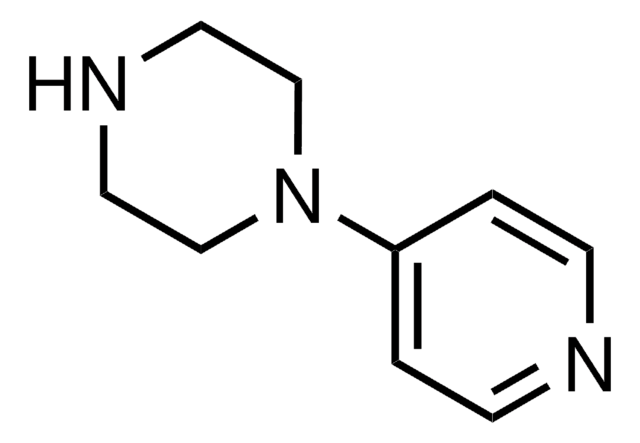421235
1-(2-Pyrimidyl)piperazine
98%
Synonyme(s) :
2-(1-Piperazinyl)pyrimidine
About This Item
Produits recommandés
Essai
98%
Indice de réfraction
n20/D 1.587 (lit.)
pb
277 °C (lit.)
Densité
1.158 g/mL at 25 °C (lit.)
Chaîne SMILES
C1CN(CCN1)c2ncccn2
InChI
1S/C8H12N4/c1-2-10-8(11-3-1)12-6-4-9-5-7-12/h1-3,9H,4-7H2
Clé InChI
MRBFGEHILMYPTF-UHFFFAOYSA-N
Vous recherchez des produits similaires ? Visite Guide de comparaison des produits
Description générale
Application
- As derivatization reagent for the carboxyl groups on peptides.[1]
- Carboxy group derivatization during the spectrophotometric analysis of phosphopeptides.[3]
- Starting reagent for the synthesis of 3-{(4-(pyrimidin-2-yl)piperazin-1-yl)methyl}-1H-pyrrolo[2,3-b]pyridine.[4]
- Synthesis of 3-phenyl-6-(4-(pyrimidin-2-yl)piperazin-1-yl)pyridazin-4-ol.[5]
Mention d'avertissement
Warning
Mentions de danger
Conseils de prudence
Classification des risques
Eye Irrit. 2 - Skin Irrit. 2 - STOT SE 3
Organes cibles
Respiratory system
Code de la classe de stockage
10 - Combustible liquids
Classe de danger pour l'eau (WGK)
WGK 3
Point d'éclair (°F)
>230.0 °F
Point d'éclair (°C)
> 110 °C
Équipement de protection individuelle
Eyeshields, Gloves, type ABEK (EN14387) respirator filter
Faites votre choix parmi les versions les plus récentes :
Déjà en possession de ce produit ?
Retrouvez la documentation relative aux produits que vous avez récemment achetés dans la Bibliothèque de documents.
Les clients ont également consulté
Active Filters
Notre équipe de scientifiques dispose d'une expérience dans tous les secteurs de la recherche, notamment en sciences de la vie, science des matériaux, synthèse chimique, chromatographie, analyse et dans de nombreux autres domaines..
Contacter notre Service technique









